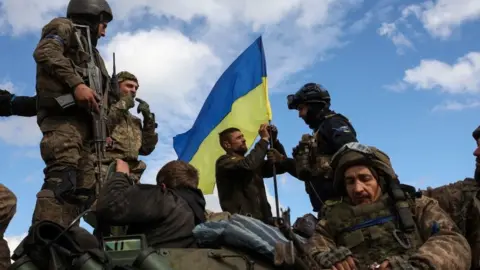Ukraine lowers combat call-up age to boost numbers
 AFP via Getty Images
AFP via Getty ImagesUkrainian President Volodymyr Zelensky has signed into law a bill lowering the military mobilisation age by two years from 27 to 25.
Kyiv and Moscow have both faced heavy losses on the battlefield after two years of war, but Russia has benefited from a sizeable advantage in manpower.
The move will allow Ukraine to call up more people to replenish its reserves, after volunteer numbers dropped.
Mr Zelensky said in December 500,000 more soldiers needed to be mobilised.
But on Wednesday, he said: "We don't need half-a-million." Last week, Ukraine's top general said the required number of mobilised soldiers had been "significantly reduced" following a review of available resources.
Ukraine's parliament approved the bill in May 2023, but it did not come into force because Mr Zelensky did not sign it.
In a separate move, Nato foreign ministers in Brussels were discussing plans for a €100bn (£86bn) five-year fund to provide long-term military support for Ukraine.
Asked if the figure was correct, Nato Secretary General Jens Stoltenberg said the framework was yet to be decided but Nato allies agreed that Ukraine needed more money and for many years.
"Make no mistake, Ukraine can rely on Nato support now and for the long haul."
Russia was "pushing" on the battlefield in Ukraine and trying to win the war by "waiting us out", Mr Stoltenberg said.
It was not immediately clear what prompted President Zelensky to sign the bill and how many additional soldiers Ukraine could now get, although he has previously warned of plans Russia may have to launch a spring or summer offensive.
And on Wednesday, the Ukrainian leader said Russia was ready to mobilise additional 300,000 troops in June.
Russia's military has not commented on the claim.
Ukrainian forces had hoped to take back swathes of territory gained by Russia as well as cutting off Russian supply lines to Crimea - Ukraine's southern peninsula illegally annexed by Russia in 2014.
But lacking air superiority and faced with formidable Russian defences, Kyiv's counter-offensive ground to a halt at the start of winter and there are fears that Russian forces could outgun Ukraine.
In the past few months, Kyiv has been actively building defence fortifications amid steady Russian advances in eastern Ukraine, including the capture of the strategic town of Avdiivka.
Last year, Ukrainian Gen Oleksandr Tarnavskyi warned troops had already been forced to downsize some military operations because of a drop-off in foreign aid.
Ukraine has relied heavily on Western supplies, particularly on deliveries of long-range missiles and air defence systems. However, billions of pounds of US and EU aid have been held up amid political wrangles.
In January 2024, Mr Zelensky said Ukraine's armed forces numbered 880,000, without specifying how many were actually fighting on the more than 1,200km-long (745 miles) frontline in the country's south-east.
In February, he said 31,000 Ukrainian soldiers had been killed since the start of Russia's full-scale invasion in February 2022, but US officials have put the number of Ukrainian soldiers killed as at least 70,000 and as many as 120,000 injured.
Russian President Vladimir Putin has said more than 600,000 of his troops are fighting in Ukraine, but has not revealed how many have lost their lives there.
A classified US intelligence report released in December estimated that 315,000 Russian soldiers had been either killed or wounded since the war began - which it said was almost 90% of Russia's military personnel at the start of the invasion.
On Wednesday, Russia's defence ministry said more than 100,000 people had signed up to serve in the country's armed forces since the start of the year.
